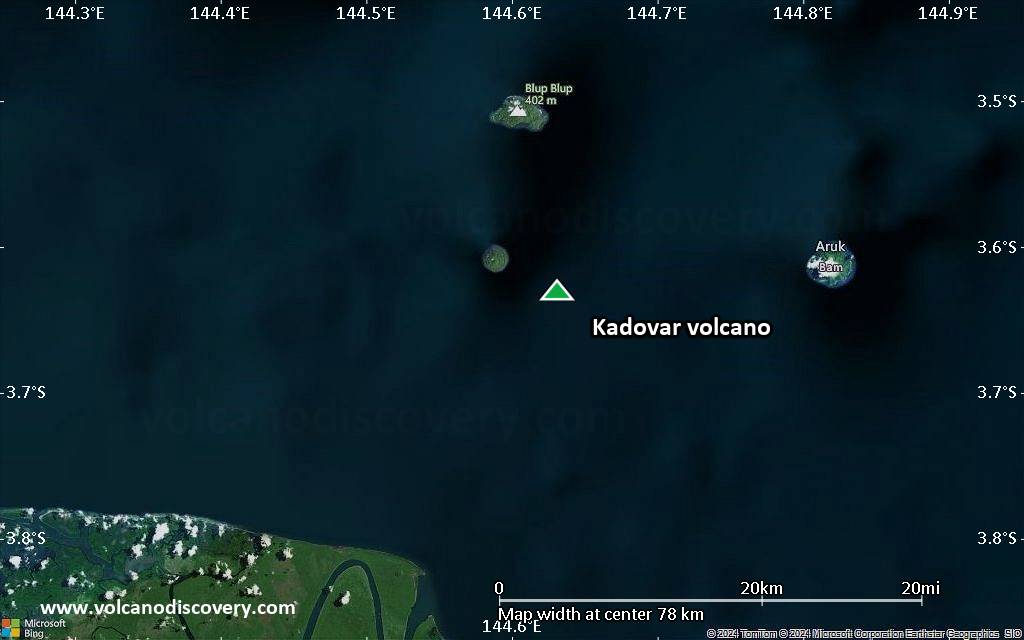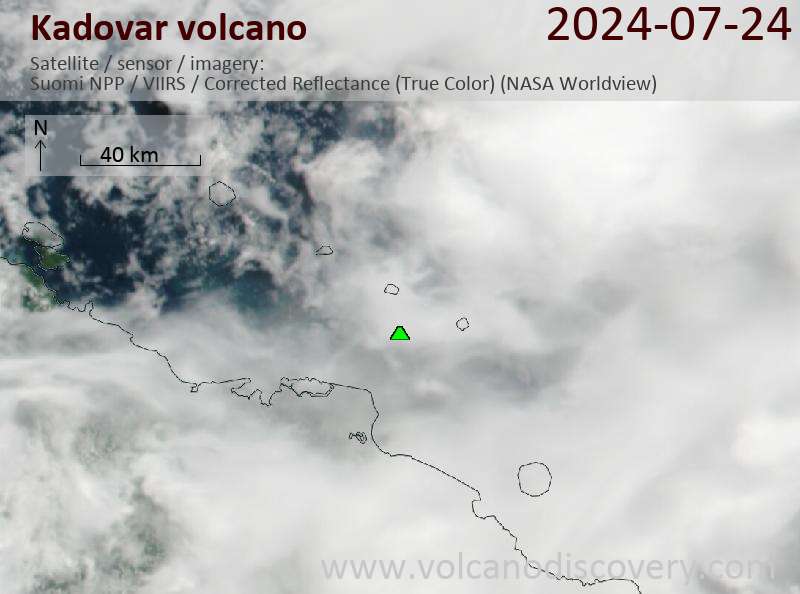Kadovar Volcano
Kadovar volcano forms the tiny 2 km wide Kadovar Island, one of the Schouten Islands. It is located 25 km north of the mouth of the Sepik River on New Guinea.
The island is the submerged peak of a stratovolcano at the western end of the 1000 km long Bismarck volcanic arc.
Kadovar contains a 1 km wide breached crater, and the village of Gewai is perched on the crater rim. There are no certain eruptions in historic time, but an increase in thermal activity occurred in 1976.
Kadovar volcano eruptions: 2018, 1700 (?)
Latest nearby earthquakes
| Date and Time | Mag / Depth | Distance / Location | |||
|---|---|---|---|---|---|
| May 21, 01:05 am (Port Moresby) | 6.5 10 km | 24 km (15 mi) to the SE | Info | ||
Background
A landslide occurred in the past, removing part of the south slope and leaving an horse-show shaped car on the south side. The corresponding submarine debris avalanche deposits have been identified. A lava 365-m-high lava dome has partly filled the depression and forms the highest point of the andesitic volcano.The volcano has produced thick lava flows with prismatic lava formations visible at low cliffs on the coast.
The volcano is too young for reefs to have formed around the island.
Significant volcanic eruptions: Kadovar volcano
| Date | Note | VEI | Deaths | Damage | ||
|---|---|---|---|---|---|---|
| Summit and SE flank Historical obs./docs. | 2 | |||||
| 2018 Feb 9 (eruption | Tsunami recorded | 2 | Info | |||
| 2018 Jan 5 (eruption | 2 | light | Info | |||
?? | Uncertain Eruption | ? | ||||
Discredited Eruption | ||||||
Eruptions of Kadovar volcano
The sea in an area off the NE was discolored with an orange stain during aerial inspections on 6 and 19 March 1981.
The volcano showed signs of a possible eruption in 1976: an increase in fumarolic activity and possible gas emission offshore were noted and all residents of Kadovar were evacuated to Blublup Island.
The first signs were noted May 1976 from an area at the S coast where possibly a small hydrothermal eruption or, more likely, a vigorous emission of gas bubbles occurred. The sea water in the area changed color and became a 100 m-long reddish zone of iron hydroxide in August.
Hot ground was first noticed up on the side of the lava dome around 16 September, and there was an increase in HCl and SO2 emissions which had a maximum temperature of 100 deg C.
In November, a second fumarole had developed near the hot ground discovered in September.
After November 1976 and throughout 1977, the activity stabililzed and later began to decline slowly starting in 1978. An observation in 1981 showed that the new hot areas had decreased in size and regrowth of vegetation has began to recover the area.
---
Source: Smithsonian / GVP monthly reports
A report of "smoke" at the volcano in 1700 could indicate an eruption.
(Smithsonian SEAN Bulletin 01:14, Jan 1976)
Kadovar Volcano FAQ
+When was the last eruption of Kadovar volcano?
The last confirmed eruption of Kadovar occurred during 2018 - 2023.
+How often does Kadovar volcano erupt?
Kadovar volcano erupts almost every year. Since its first historically documented eruption 2018, Kadovar has often been near-continuously active. The Global Volcanism Project counts 1 historic eruptions until now, spanning a total of 6 out of 7 years. In other words, Kadovar is active roughly every one in 1.2 years on average. This value is likely an underestimate, because the known history of eruption might not contain all eruptions, especially further back in time. The last eruption of Kadovar
+How active is Kadovar volcano at present?
Kadovar volcano is occasionally active: Since 1900, it has had 6 eruptions, and been active during 6 years out of 126 as of now. This means, Kadovar has been in eruption one in 21 years on average. The last eruption was from 2018 until 2023 and ended 3 years ago.
+When was the largest eruption of Kadovar volcano?
The largest eruption of Kadovar volcano in historic times occurred during 2018 - 2023. It ranks as a strombolian to vulcanian eruption with a magnitude 2 on the VEI (Volcanic Explosivity Index) scale.
Latest satellite images
Kadovar Volcano Maps





































